Analyzing Booths Supermarket's Supply Chain: A Focus on Sustainability
VerifiedAdded on 2023/06/16
|7
|2045
|245
Report
AI Summary
This report analyzes Booths Supermarket's supply chain, emphasizing sustainability and environmental impact reduction. It explores components of a localized food supply chain in West Yorkshire, such as green procurement, green design, reverse logistics, green manufacturing, and waste management, all aimed at minimizing carbon footprints. The report also discusses planning and coordination strategies for food manufacture and supply, including the use of natural resources, sustainable sourcing of food ingredients, eco-friendly packaging materials, and protection of natural resources. By implementing these sustainable practices, Booths Supermarket aims to improve its overall performance while minimizing its environmental impact, ultimately contributing to a more sustainable food supply chain.

Booths Supermarket supply chain
Paraphrase This Document
Need a fresh take? Get an instant paraphrase of this document with our AI Paraphraser
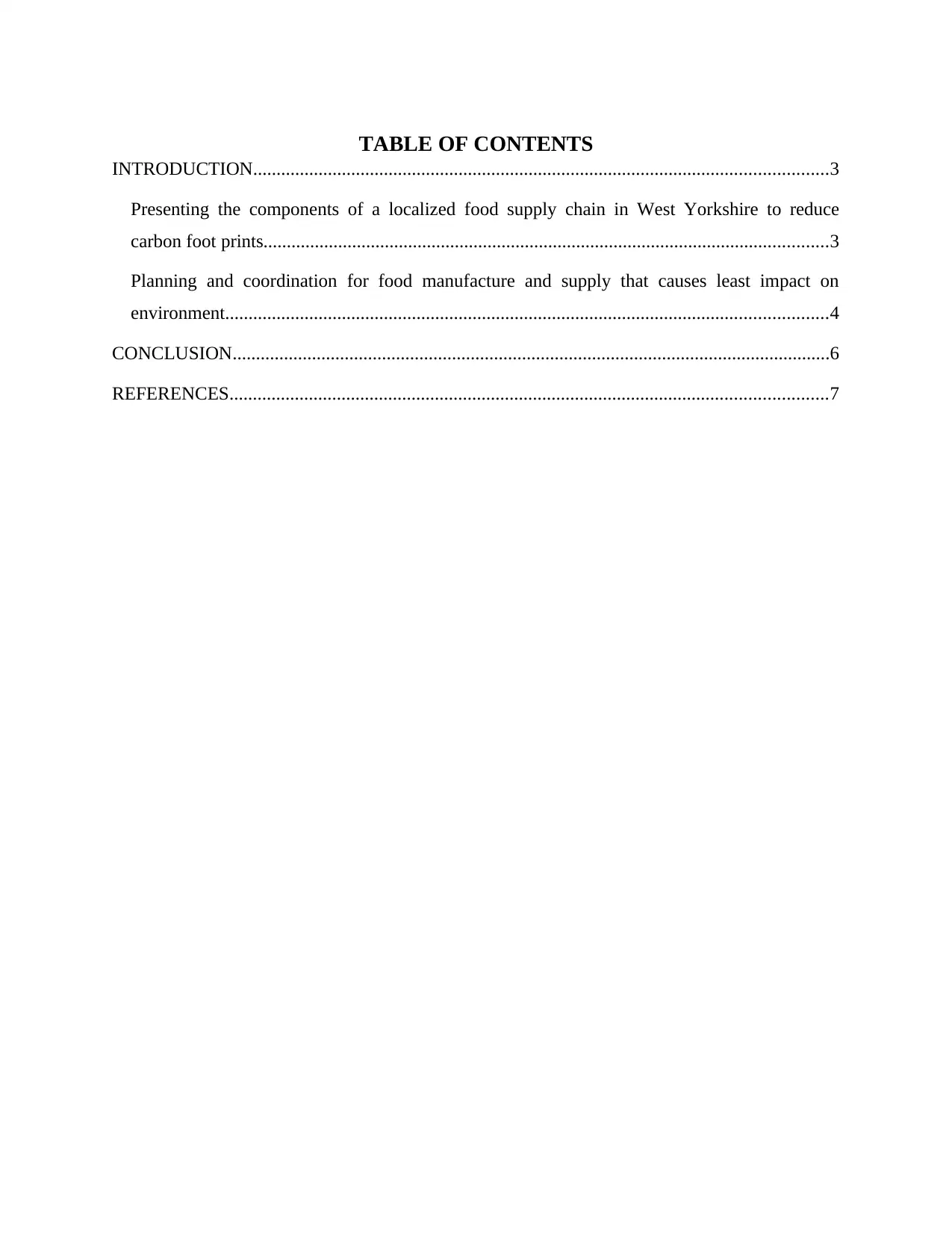
TABLE OF CONTENTS
INTRODUCTION...........................................................................................................................3
Presenting the components of a localized food supply chain in West Yorkshire to reduce
carbon foot prints.........................................................................................................................3
Planning and coordination for food manufacture and supply that causes least impact on
environment.................................................................................................................................4
CONCLUSION................................................................................................................................6
REFERENCES................................................................................................................................7
INTRODUCTION...........................................................................................................................3
Presenting the components of a localized food supply chain in West Yorkshire to reduce
carbon foot prints.........................................................................................................................3
Planning and coordination for food manufacture and supply that causes least impact on
environment.................................................................................................................................4
CONCLUSION................................................................................................................................6
REFERENCES................................................................................................................................7
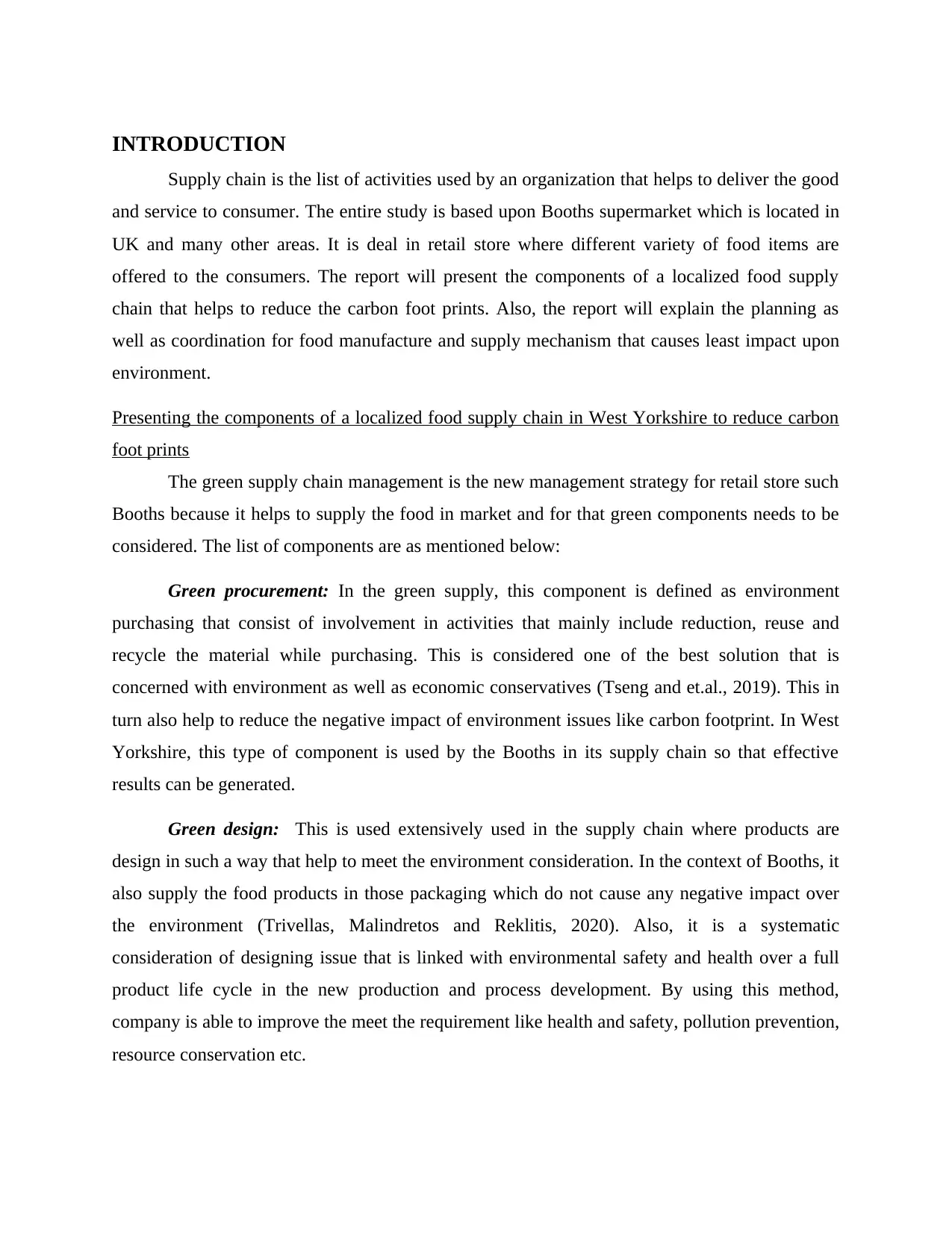
INTRODUCTION
Supply chain is the list of activities used by an organization that helps to deliver the good
and service to consumer. The entire study is based upon Booths supermarket which is located in
UK and many other areas. It is deal in retail store where different variety of food items are
offered to the consumers. The report will present the components of a localized food supply
chain that helps to reduce the carbon foot prints. Also, the report will explain the planning as
well as coordination for food manufacture and supply mechanism that causes least impact upon
environment.
Presenting the components of a localized food supply chain in West Yorkshire to reduce carbon
foot prints
The green supply chain management is the new management strategy for retail store such
Booths because it helps to supply the food in market and for that green components needs to be
considered. The list of components are as mentioned below:
Green procurement: In the green supply, this component is defined as environment
purchasing that consist of involvement in activities that mainly include reduction, reuse and
recycle the material while purchasing. This is considered one of the best solution that is
concerned with environment as well as economic conservatives (Tseng and et.al., 2019). This in
turn also help to reduce the negative impact of environment issues like carbon footprint. In West
Yorkshire, this type of component is used by the Booths in its supply chain so that effective
results can be generated.
Green design: This is used extensively used in the supply chain where products are
design in such a way that help to meet the environment consideration. In the context of Booths, it
also supply the food products in those packaging which do not cause any negative impact over
the environment (Trivellas, Malindretos and Reklitis, 2020). Also, it is a systematic
consideration of designing issue that is linked with environmental safety and health over a full
product life cycle in the new production and process development. By using this method,
company is able to improve the meet the requirement like health and safety, pollution prevention,
resource conservation etc.
Supply chain is the list of activities used by an organization that helps to deliver the good
and service to consumer. The entire study is based upon Booths supermarket which is located in
UK and many other areas. It is deal in retail store where different variety of food items are
offered to the consumers. The report will present the components of a localized food supply
chain that helps to reduce the carbon foot prints. Also, the report will explain the planning as
well as coordination for food manufacture and supply mechanism that causes least impact upon
environment.
Presenting the components of a localized food supply chain in West Yorkshire to reduce carbon
foot prints
The green supply chain management is the new management strategy for retail store such
Booths because it helps to supply the food in market and for that green components needs to be
considered. The list of components are as mentioned below:
Green procurement: In the green supply, this component is defined as environment
purchasing that consist of involvement in activities that mainly include reduction, reuse and
recycle the material while purchasing. This is considered one of the best solution that is
concerned with environment as well as economic conservatives (Tseng and et.al., 2019). This in
turn also help to reduce the negative impact of environment issues like carbon footprint. In West
Yorkshire, this type of component is used by the Booths in its supply chain so that effective
results can be generated.
Green design: This is used extensively used in the supply chain where products are
design in such a way that help to meet the environment consideration. In the context of Booths, it
also supply the food products in those packaging which do not cause any negative impact over
the environment (Trivellas, Malindretos and Reklitis, 2020). Also, it is a systematic
consideration of designing issue that is linked with environmental safety and health over a full
product life cycle in the new production and process development. By using this method,
company is able to improve the meet the requirement like health and safety, pollution prevention,
resource conservation etc.
⊘ This is a preview!⊘
Do you want full access?
Subscribe today to unlock all pages.

Trusted by 1+ million students worldwide
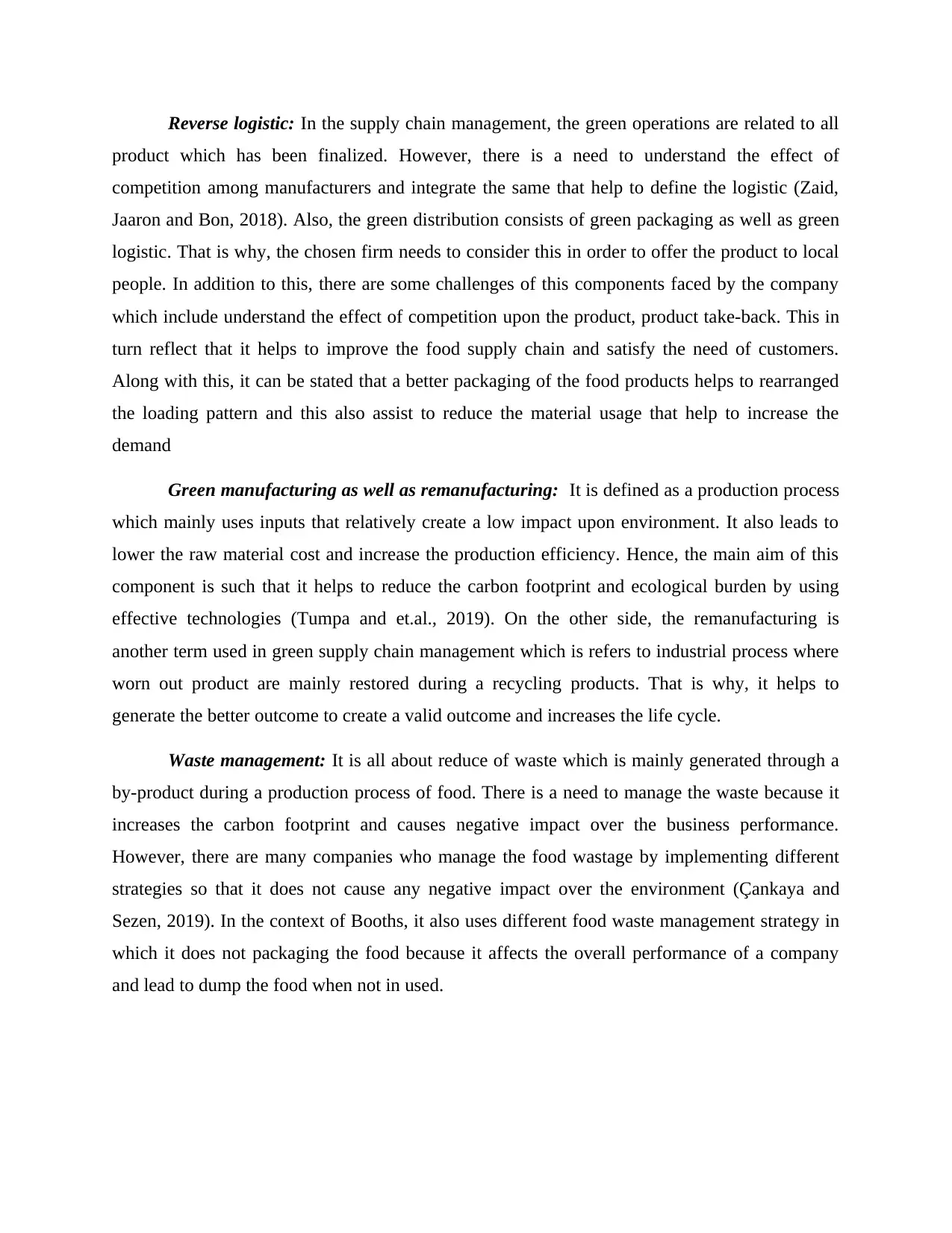
Reverse logistic: In the supply chain management, the green operations are related to all
product which has been finalized. However, there is a need to understand the effect of
competition among manufacturers and integrate the same that help to define the logistic (Zaid,
Jaaron and Bon, 2018). Also, the green distribution consists of green packaging as well as green
logistic. That is why, the chosen firm needs to consider this in order to offer the product to local
people. In addition to this, there are some challenges of this components faced by the company
which include understand the effect of competition upon the product, product take-back. This in
turn reflect that it helps to improve the food supply chain and satisfy the need of customers.
Along with this, it can be stated that a better packaging of the food products helps to rearranged
the loading pattern and this also assist to reduce the material usage that help to increase the
demand
Green manufacturing as well as remanufacturing: It is defined as a production process
which mainly uses inputs that relatively create a low impact upon environment. It also leads to
lower the raw material cost and increase the production efficiency. Hence, the main aim of this
component is such that it helps to reduce the carbon footprint and ecological burden by using
effective technologies (Tumpa and et.al., 2019). On the other side, the remanufacturing is
another term used in green supply chain management which is refers to industrial process where
worn out product are mainly restored during a recycling products. That is why, it helps to
generate the better outcome to create a valid outcome and increases the life cycle.
Waste management: It is all about reduce of waste which is mainly generated through a
by-product during a production process of food. There is a need to manage the waste because it
increases the carbon footprint and causes negative impact over the business performance.
However, there are many companies who manage the food wastage by implementing different
strategies so that it does not cause any negative impact over the environment (Çankaya and
Sezen, 2019). In the context of Booths, it also uses different food waste management strategy in
which it does not packaging the food because it affects the overall performance of a company
and lead to dump the food when not in used.
product which has been finalized. However, there is a need to understand the effect of
competition among manufacturers and integrate the same that help to define the logistic (Zaid,
Jaaron and Bon, 2018). Also, the green distribution consists of green packaging as well as green
logistic. That is why, the chosen firm needs to consider this in order to offer the product to local
people. In addition to this, there are some challenges of this components faced by the company
which include understand the effect of competition upon the product, product take-back. This in
turn reflect that it helps to improve the food supply chain and satisfy the need of customers.
Along with this, it can be stated that a better packaging of the food products helps to rearranged
the loading pattern and this also assist to reduce the material usage that help to increase the
demand
Green manufacturing as well as remanufacturing: It is defined as a production process
which mainly uses inputs that relatively create a low impact upon environment. It also leads to
lower the raw material cost and increase the production efficiency. Hence, the main aim of this
component is such that it helps to reduce the carbon footprint and ecological burden by using
effective technologies (Tumpa and et.al., 2019). On the other side, the remanufacturing is
another term used in green supply chain management which is refers to industrial process where
worn out product are mainly restored during a recycling products. That is why, it helps to
generate the better outcome to create a valid outcome and increases the life cycle.
Waste management: It is all about reduce of waste which is mainly generated through a
by-product during a production process of food. There is a need to manage the waste because it
increases the carbon footprint and causes negative impact over the business performance.
However, there are many companies who manage the food wastage by implementing different
strategies so that it does not cause any negative impact over the environment (Çankaya and
Sezen, 2019). In the context of Booths, it also uses different food waste management strategy in
which it does not packaging the food because it affects the overall performance of a company
and lead to dump the food when not in used.
Paraphrase This Document
Need a fresh take? Get an instant paraphrase of this document with our AI Paraphraser
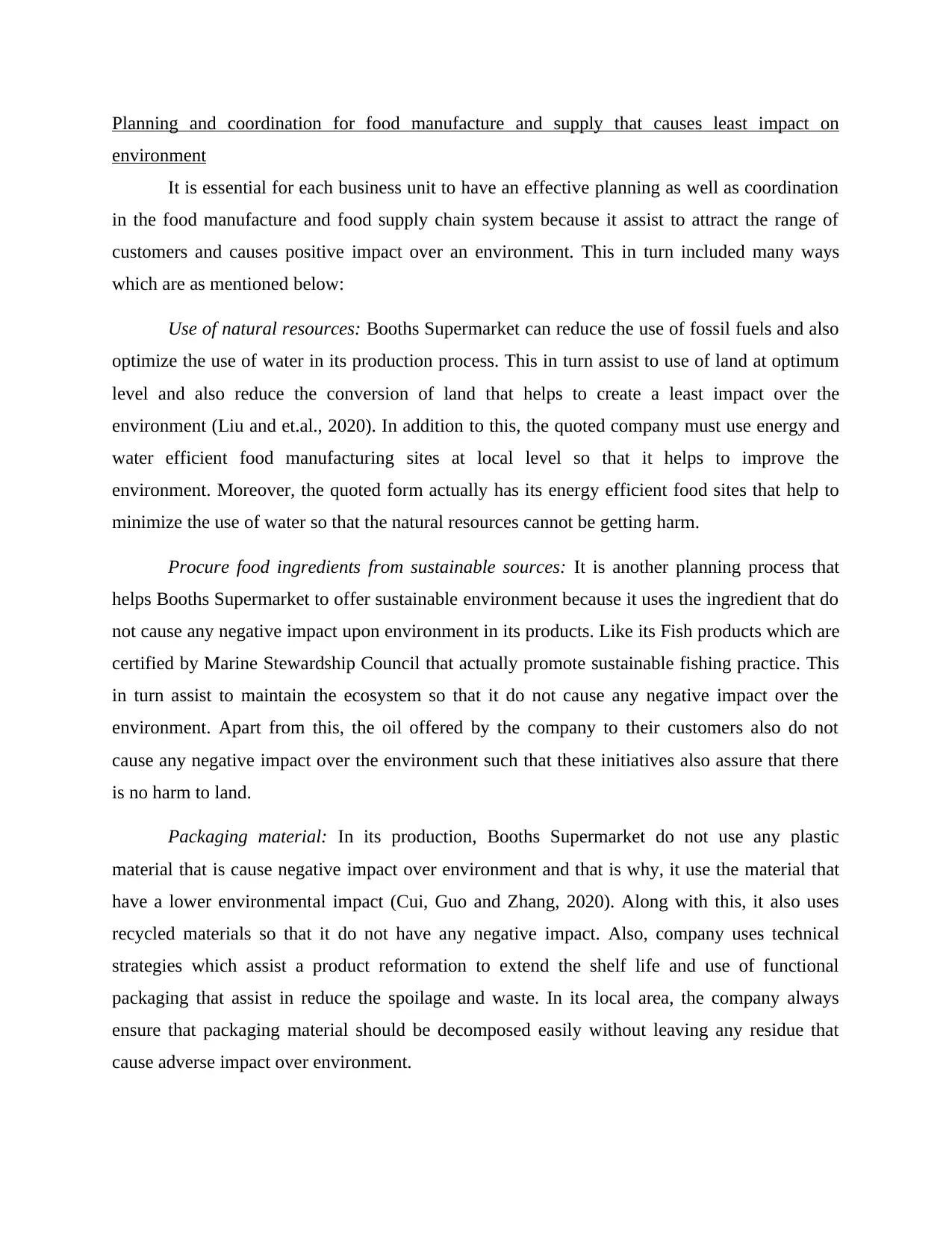
Planning and coordination for food manufacture and supply that causes least impact on
environment
It is essential for each business unit to have an effective planning as well as coordination
in the food manufacture and food supply chain system because it assist to attract the range of
customers and causes positive impact over an environment. This in turn included many ways
which are as mentioned below:
Use of natural resources: Booths Supermarket can reduce the use of fossil fuels and also
optimize the use of water in its production process. This in turn assist to use of land at optimum
level and also reduce the conversion of land that helps to create a least impact over the
environment (Liu and et.al., 2020). In addition to this, the quoted company must use energy and
water efficient food manufacturing sites at local level so that it helps to improve the
environment. Moreover, the quoted form actually has its energy efficient food sites that help to
minimize the use of water so that the natural resources cannot be getting harm.
Procure food ingredients from sustainable sources: It is another planning process that
helps Booths Supermarket to offer sustainable environment because it uses the ingredient that do
not cause any negative impact upon environment in its products. Like its Fish products which are
certified by Marine Stewardship Council that actually promote sustainable fishing practice. This
in turn assist to maintain the ecosystem so that it do not cause any negative impact over the
environment. Apart from this, the oil offered by the company to their customers also do not
cause any negative impact over the environment such that these initiatives also assure that there
is no harm to land.
Packaging material: In its production, Booths Supermarket do not use any plastic
material that is cause negative impact over environment and that is why, it use the material that
have a lower environmental impact (Cui, Guo and Zhang, 2020). Along with this, it also uses
recycled materials so that it do not have any negative impact. Also, company uses technical
strategies which assist a product reformation to extend the shelf life and use of functional
packaging that assist in reduce the spoilage and waste. In its local area, the company always
ensure that packaging material should be decomposed easily without leaving any residue that
cause adverse impact over environment.
environment
It is essential for each business unit to have an effective planning as well as coordination
in the food manufacture and food supply chain system because it assist to attract the range of
customers and causes positive impact over an environment. This in turn included many ways
which are as mentioned below:
Use of natural resources: Booths Supermarket can reduce the use of fossil fuels and also
optimize the use of water in its production process. This in turn assist to use of land at optimum
level and also reduce the conversion of land that helps to create a least impact over the
environment (Liu and et.al., 2020). In addition to this, the quoted company must use energy and
water efficient food manufacturing sites at local level so that it helps to improve the
environment. Moreover, the quoted form actually has its energy efficient food sites that help to
minimize the use of water so that the natural resources cannot be getting harm.
Procure food ingredients from sustainable sources: It is another planning process that
helps Booths Supermarket to offer sustainable environment because it uses the ingredient that do
not cause any negative impact upon environment in its products. Like its Fish products which are
certified by Marine Stewardship Council that actually promote sustainable fishing practice. This
in turn assist to maintain the ecosystem so that it do not cause any negative impact over the
environment. Apart from this, the oil offered by the company to their customers also do not
cause any negative impact over the environment such that these initiatives also assure that there
is no harm to land.
Packaging material: In its production, Booths Supermarket do not use any plastic
material that is cause negative impact over environment and that is why, it use the material that
have a lower environmental impact (Cui, Guo and Zhang, 2020). Along with this, it also uses
recycled materials so that it do not have any negative impact. Also, company uses technical
strategies which assist a product reformation to extend the shelf life and use of functional
packaging that assist in reduce the spoilage and waste. In its local area, the company always
ensure that packaging material should be decomposed easily without leaving any residue that
cause adverse impact over environment.
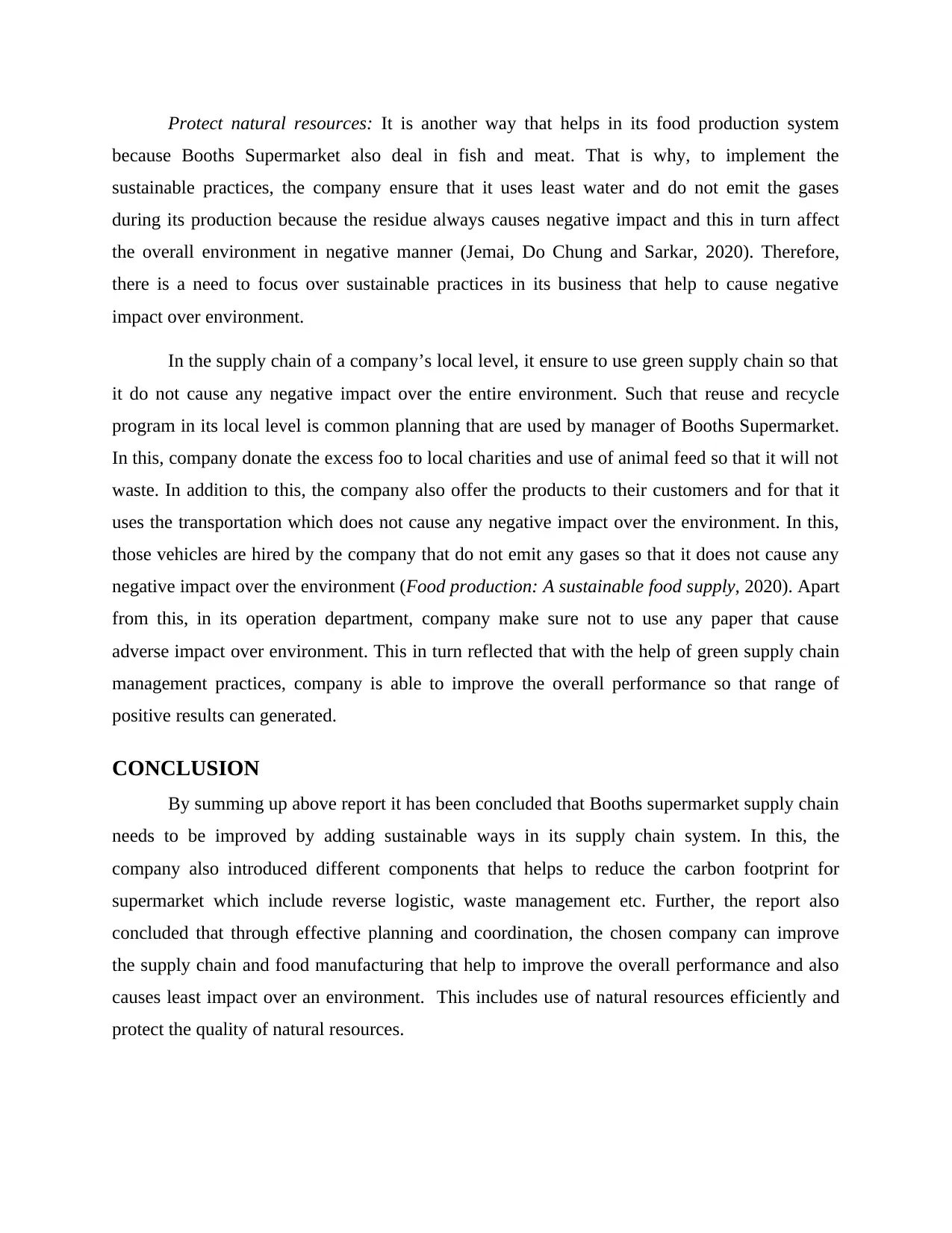
Protect natural resources: It is another way that helps in its food production system
because Booths Supermarket also deal in fish and meat. That is why, to implement the
sustainable practices, the company ensure that it uses least water and do not emit the gases
during its production because the residue always causes negative impact and this in turn affect
the overall environment in negative manner (Jemai, Do Chung and Sarkar, 2020). Therefore,
there is a need to focus over sustainable practices in its business that help to cause negative
impact over environment.
In the supply chain of a company’s local level, it ensure to use green supply chain so that
it do not cause any negative impact over the entire environment. Such that reuse and recycle
program in its local level is common planning that are used by manager of Booths Supermarket.
In this, company donate the excess foo to local charities and use of animal feed so that it will not
waste. In addition to this, the company also offer the products to their customers and for that it
uses the transportation which does not cause any negative impact over the environment. In this,
those vehicles are hired by the company that do not emit any gases so that it does not cause any
negative impact over the environment (Food production: A sustainable food supply, 2020). Apart
from this, in its operation department, company make sure not to use any paper that cause
adverse impact over environment. This in turn reflected that with the help of green supply chain
management practices, company is able to improve the overall performance so that range of
positive results can generated.
CONCLUSION
By summing up above report it has been concluded that Booths supermarket supply chain
needs to be improved by adding sustainable ways in its supply chain system. In this, the
company also introduced different components that helps to reduce the carbon footprint for
supermarket which include reverse logistic, waste management etc. Further, the report also
concluded that through effective planning and coordination, the chosen company can improve
the supply chain and food manufacturing that help to improve the overall performance and also
causes least impact over an environment. This includes use of natural resources efficiently and
protect the quality of natural resources.
because Booths Supermarket also deal in fish and meat. That is why, to implement the
sustainable practices, the company ensure that it uses least water and do not emit the gases
during its production because the residue always causes negative impact and this in turn affect
the overall environment in negative manner (Jemai, Do Chung and Sarkar, 2020). Therefore,
there is a need to focus over sustainable practices in its business that help to cause negative
impact over environment.
In the supply chain of a company’s local level, it ensure to use green supply chain so that
it do not cause any negative impact over the entire environment. Such that reuse and recycle
program in its local level is common planning that are used by manager of Booths Supermarket.
In this, company donate the excess foo to local charities and use of animal feed so that it will not
waste. In addition to this, the company also offer the products to their customers and for that it
uses the transportation which does not cause any negative impact over the environment. In this,
those vehicles are hired by the company that do not emit any gases so that it does not cause any
negative impact over the environment (Food production: A sustainable food supply, 2020). Apart
from this, in its operation department, company make sure not to use any paper that cause
adverse impact over environment. This in turn reflected that with the help of green supply chain
management practices, company is able to improve the overall performance so that range of
positive results can generated.
CONCLUSION
By summing up above report it has been concluded that Booths supermarket supply chain
needs to be improved by adding sustainable ways in its supply chain system. In this, the
company also introduced different components that helps to reduce the carbon footprint for
supermarket which include reverse logistic, waste management etc. Further, the report also
concluded that through effective planning and coordination, the chosen company can improve
the supply chain and food manufacturing that help to improve the overall performance and also
causes least impact over an environment. This includes use of natural resources efficiently and
protect the quality of natural resources.
⊘ This is a preview!⊘
Do you want full access?
Subscribe today to unlock all pages.

Trusted by 1+ million students worldwide
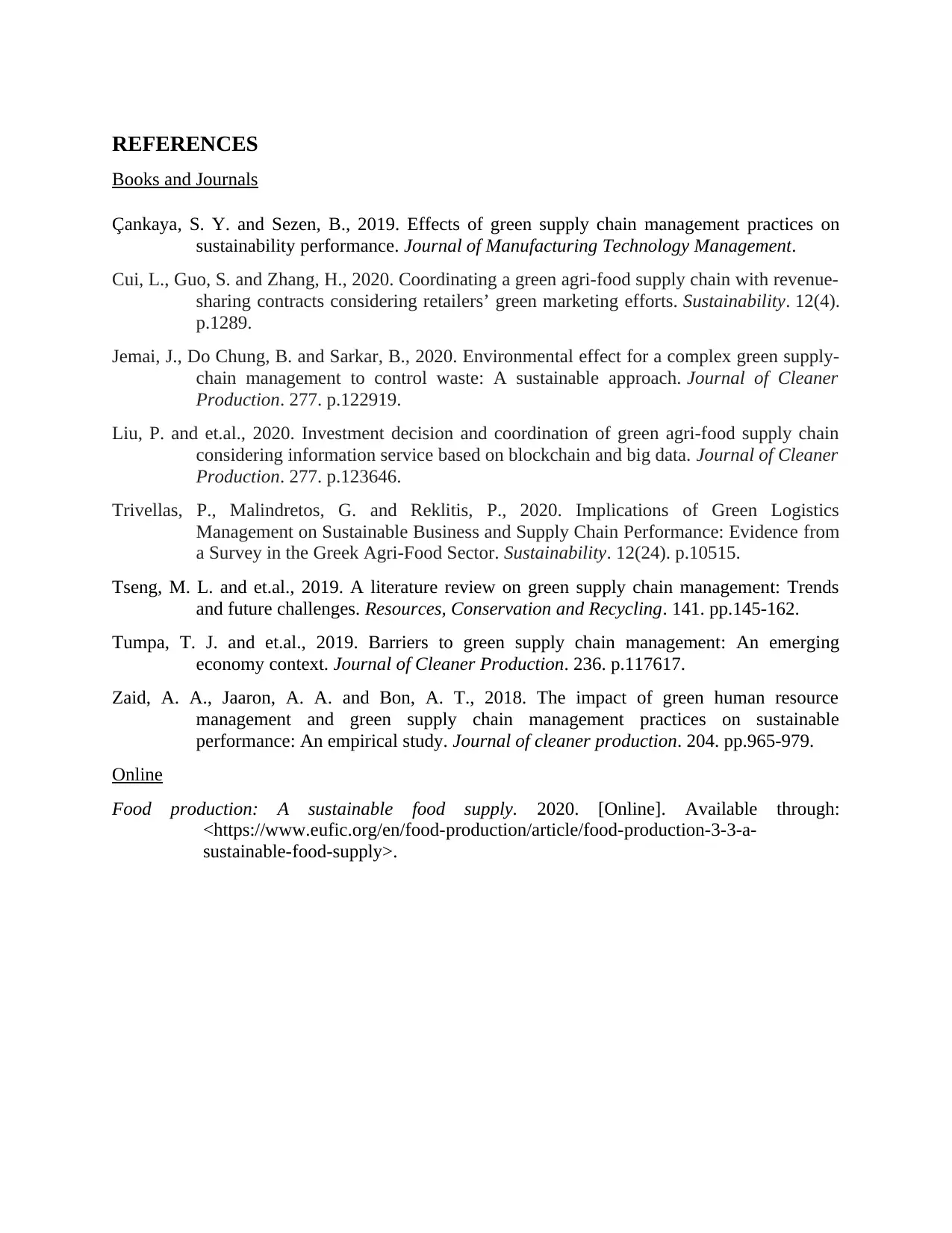
REFERENCES
Books and Journals
Çankaya, S. Y. and Sezen, B., 2019. Effects of green supply chain management practices on
sustainability performance. Journal of Manufacturing Technology Management.
Cui, L., Guo, S. and Zhang, H., 2020. Coordinating a green agri-food supply chain with revenue-
sharing contracts considering retailers’ green marketing efforts. Sustainability. 12(4).
p.1289.
Jemai, J., Do Chung, B. and Sarkar, B., 2020. Environmental effect for a complex green supply-
chain management to control waste: A sustainable approach. Journal of Cleaner
Production. 277. p.122919.
Liu, P. and et.al., 2020. Investment decision and coordination of green agri-food supply chain
considering information service based on blockchain and big data. Journal of Cleaner
Production. 277. p.123646.
Trivellas, P., Malindretos, G. and Reklitis, P., 2020. Implications of Green Logistics
Management on Sustainable Business and Supply Chain Performance: Evidence from
a Survey in the Greek Agri-Food Sector. Sustainability. 12(24). p.10515.
Tseng, M. L. and et.al., 2019. A literature review on green supply chain management: Trends
and future challenges. Resources, Conservation and Recycling. 141. pp.145-162.
Tumpa, T. J. and et.al., 2019. Barriers to green supply chain management: An emerging
economy context. Journal of Cleaner Production. 236. p.117617.
Zaid, A. A., Jaaron, A. A. and Bon, A. T., 2018. The impact of green human resource
management and green supply chain management practices on sustainable
performance: An empirical study. Journal of cleaner production. 204. pp.965-979.
Online
Food production: A sustainable food supply. 2020. [Online]. Available through:
<https://www.eufic.org/en/food-production/article/food-production-3-3-a-
sustainable-food-supply>.
Books and Journals
Çankaya, S. Y. and Sezen, B., 2019. Effects of green supply chain management practices on
sustainability performance. Journal of Manufacturing Technology Management.
Cui, L., Guo, S. and Zhang, H., 2020. Coordinating a green agri-food supply chain with revenue-
sharing contracts considering retailers’ green marketing efforts. Sustainability. 12(4).
p.1289.
Jemai, J., Do Chung, B. and Sarkar, B., 2020. Environmental effect for a complex green supply-
chain management to control waste: A sustainable approach. Journal of Cleaner
Production. 277. p.122919.
Liu, P. and et.al., 2020. Investment decision and coordination of green agri-food supply chain
considering information service based on blockchain and big data. Journal of Cleaner
Production. 277. p.123646.
Trivellas, P., Malindretos, G. and Reklitis, P., 2020. Implications of Green Logistics
Management on Sustainable Business and Supply Chain Performance: Evidence from
a Survey in the Greek Agri-Food Sector. Sustainability. 12(24). p.10515.
Tseng, M. L. and et.al., 2019. A literature review on green supply chain management: Trends
and future challenges. Resources, Conservation and Recycling. 141. pp.145-162.
Tumpa, T. J. and et.al., 2019. Barriers to green supply chain management: An emerging
economy context. Journal of Cleaner Production. 236. p.117617.
Zaid, A. A., Jaaron, A. A. and Bon, A. T., 2018. The impact of green human resource
management and green supply chain management practices on sustainable
performance: An empirical study. Journal of cleaner production. 204. pp.965-979.
Online
Food production: A sustainable food supply. 2020. [Online]. Available through:
<https://www.eufic.org/en/food-production/article/food-production-3-3-a-
sustainable-food-supply>.
1 out of 7
Related Documents
Your All-in-One AI-Powered Toolkit for Academic Success.
+13062052269
info@desklib.com
Available 24*7 on WhatsApp / Email
![[object Object]](/_next/static/media/star-bottom.7253800d.svg)
Unlock your academic potential
Copyright © 2020–2025 A2Z Services. All Rights Reserved. Developed and managed by ZUCOL.





